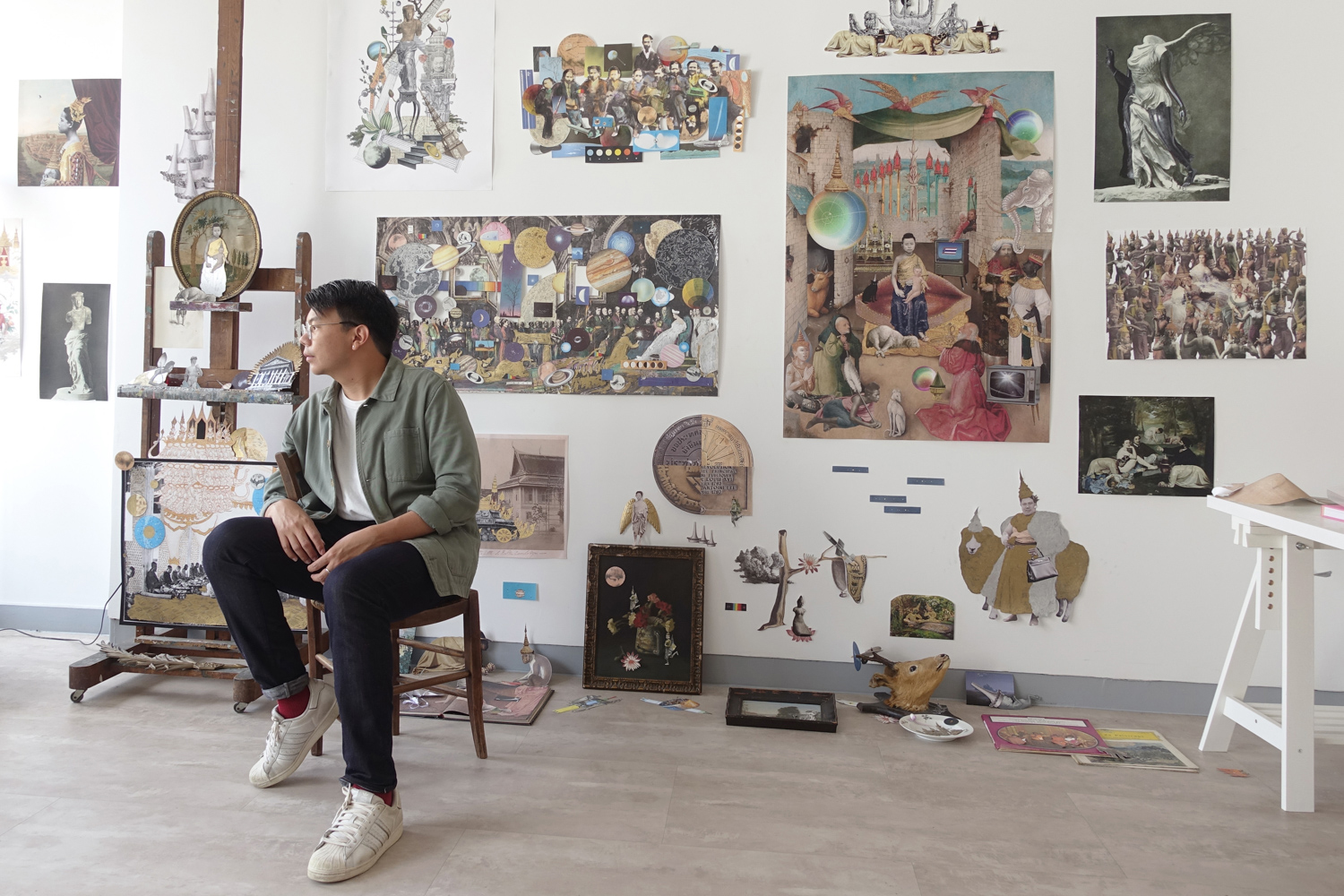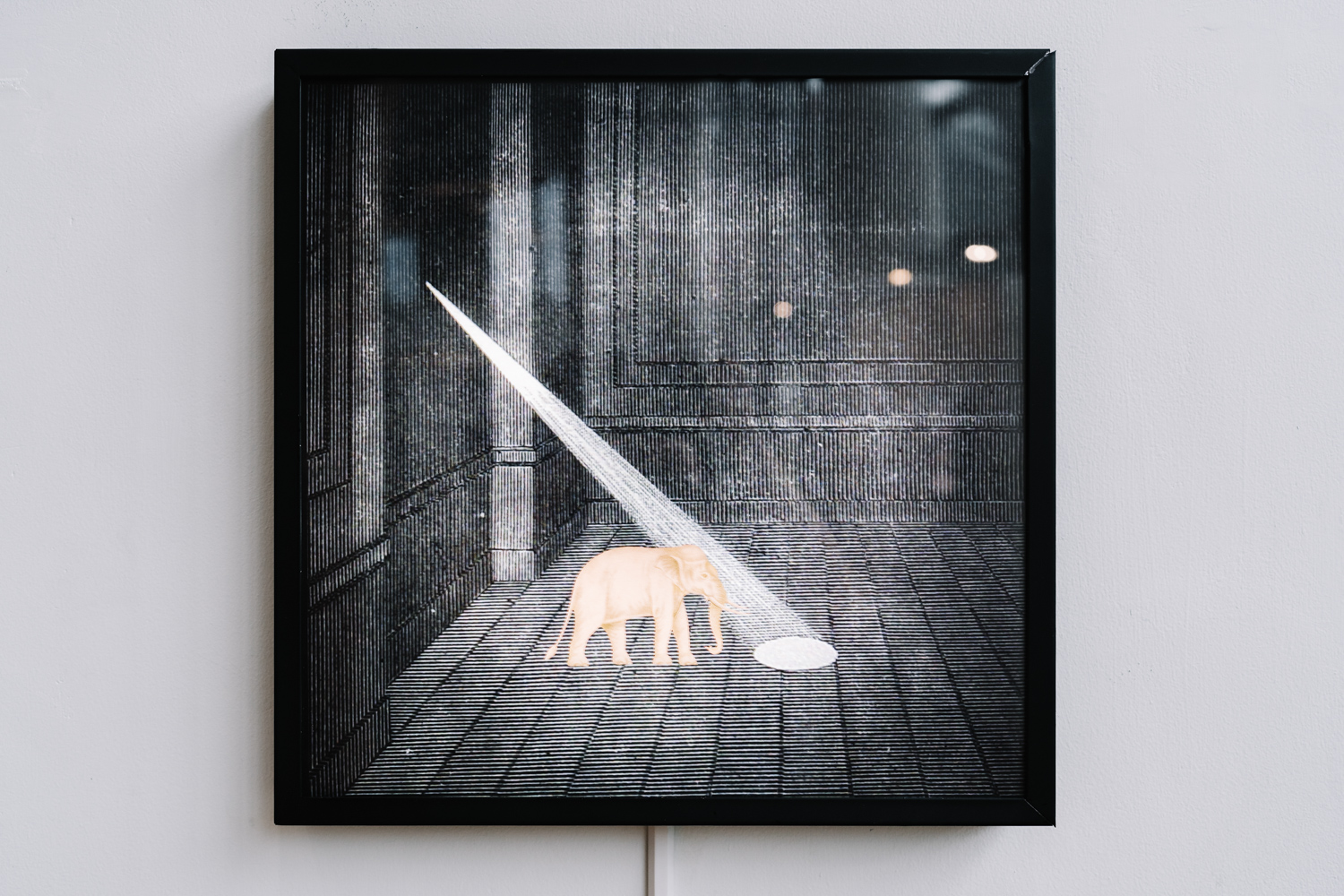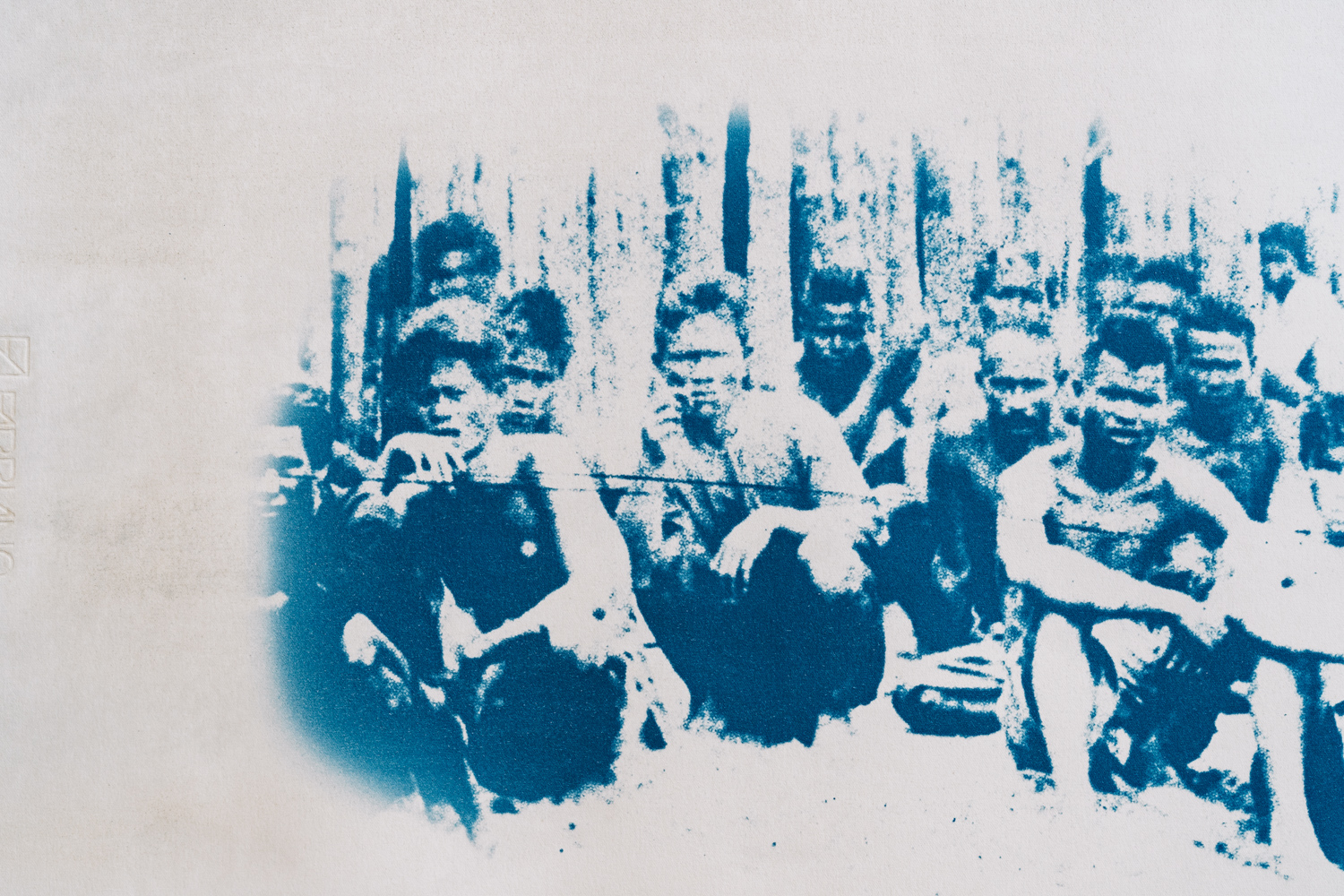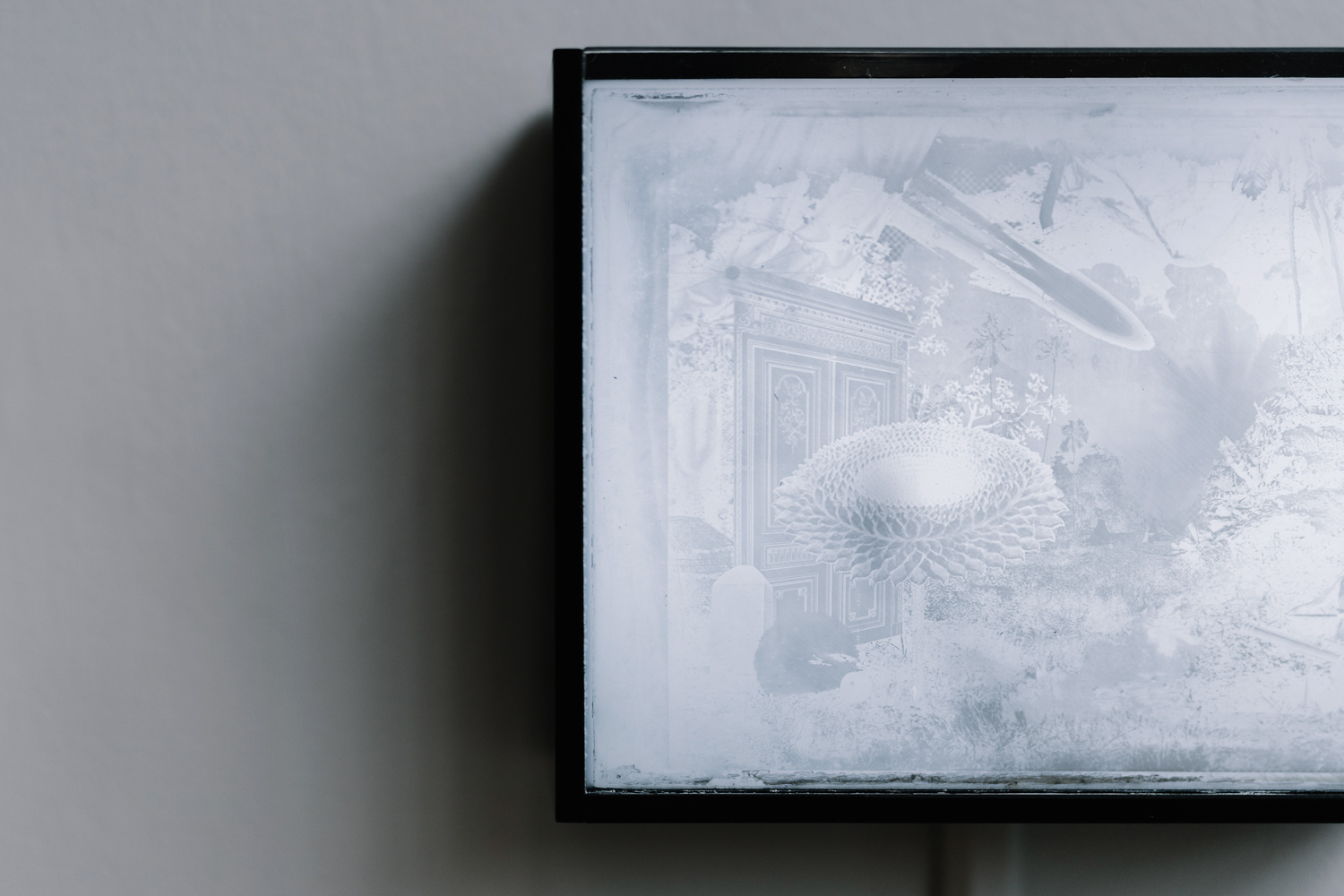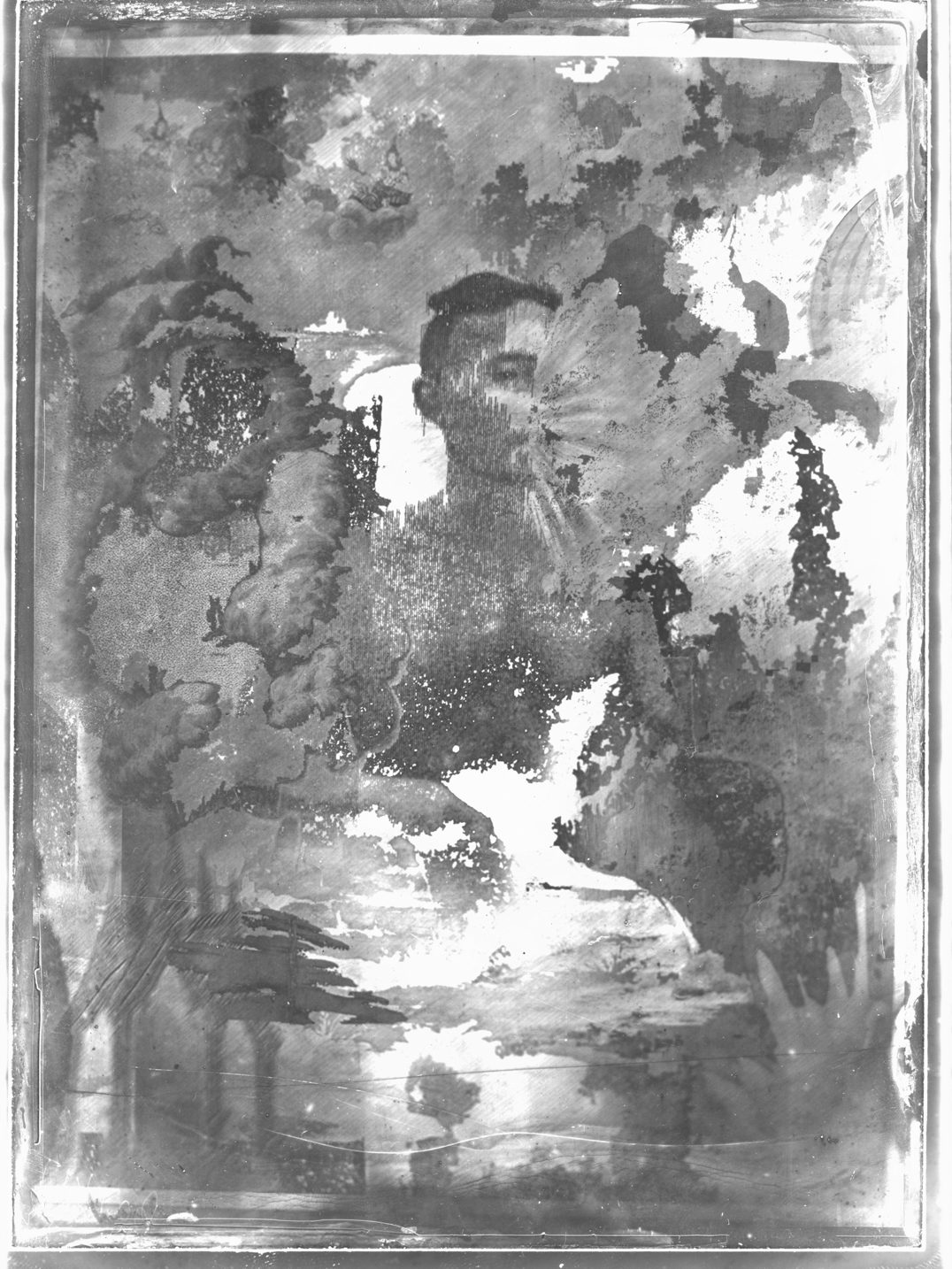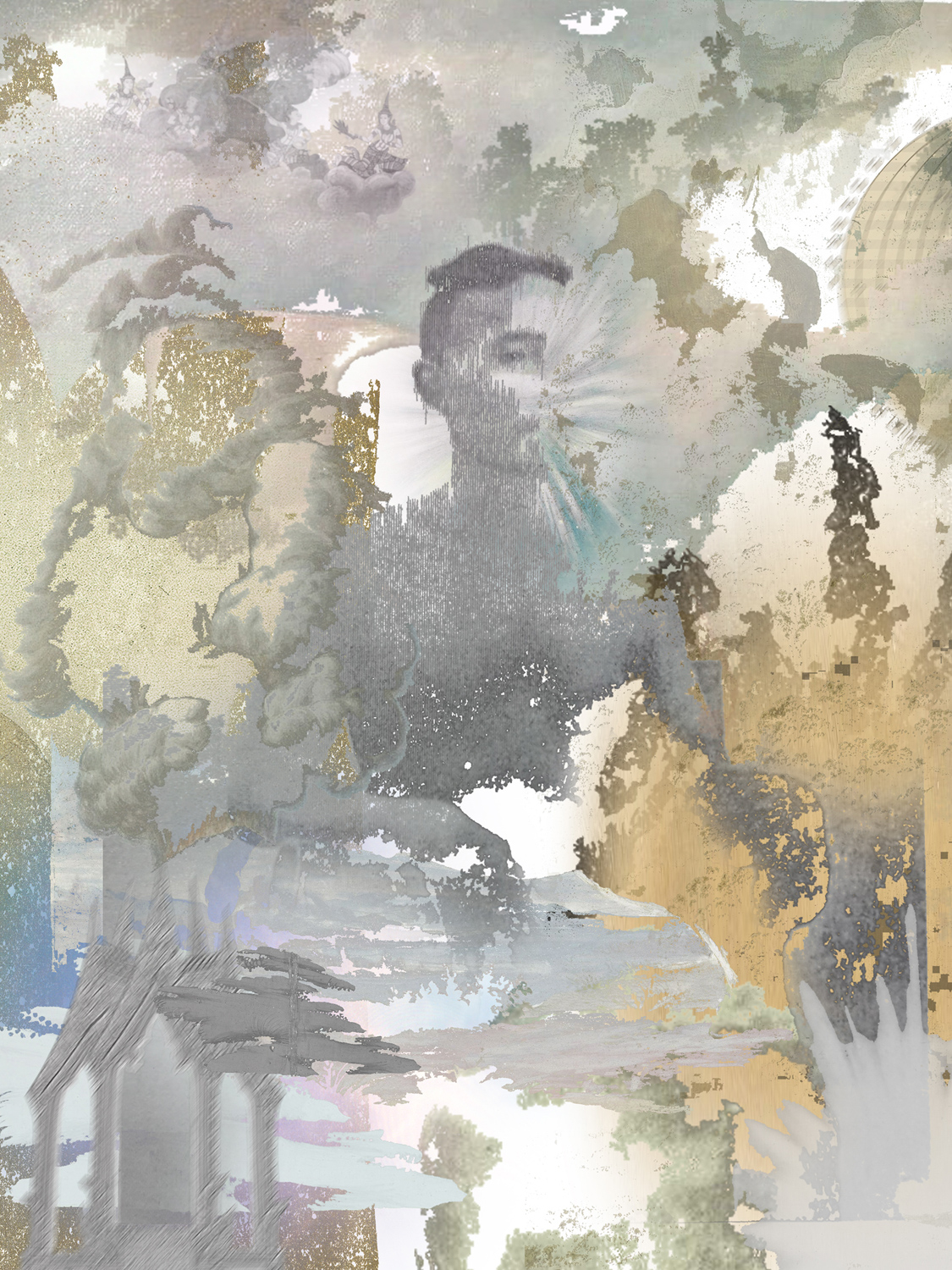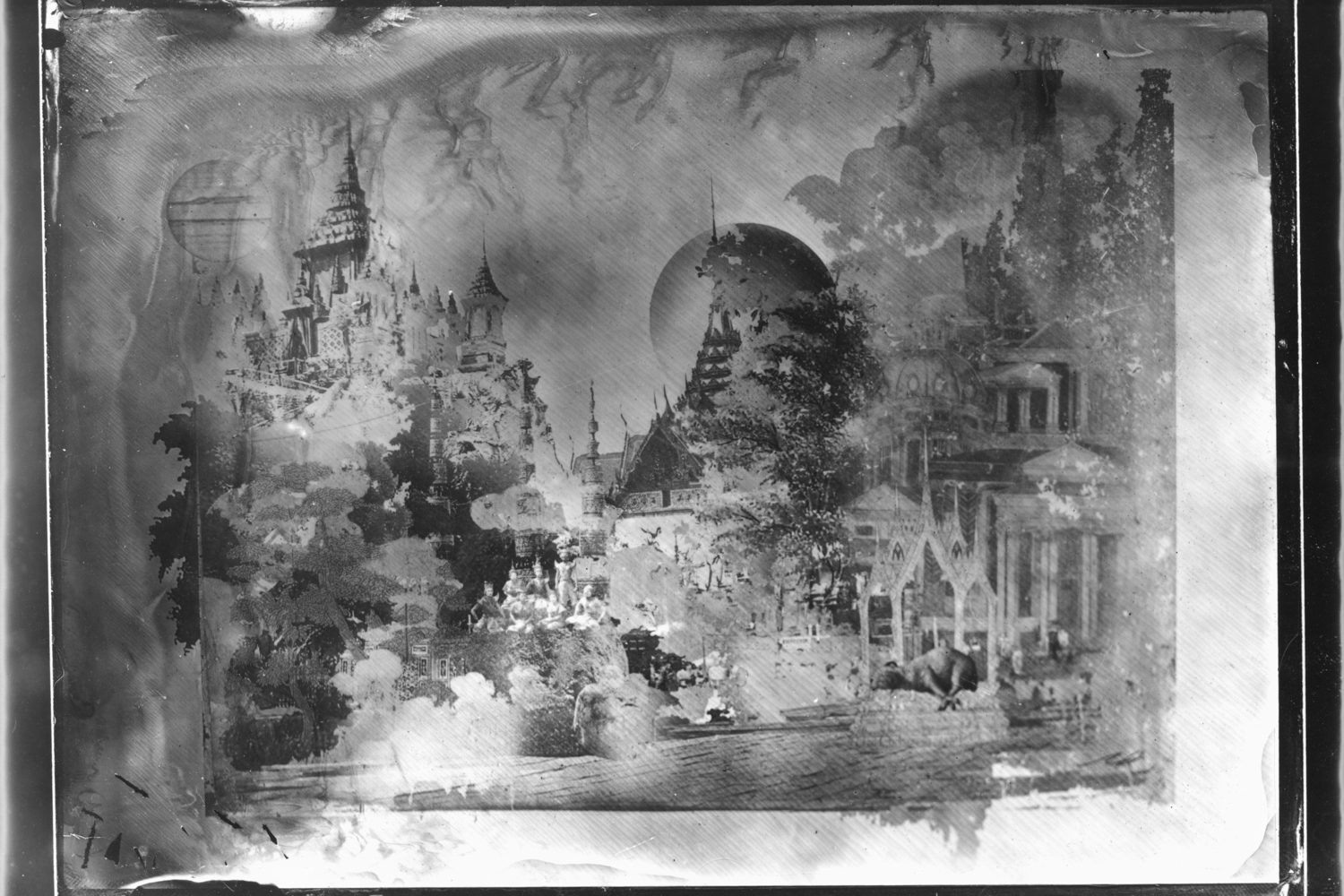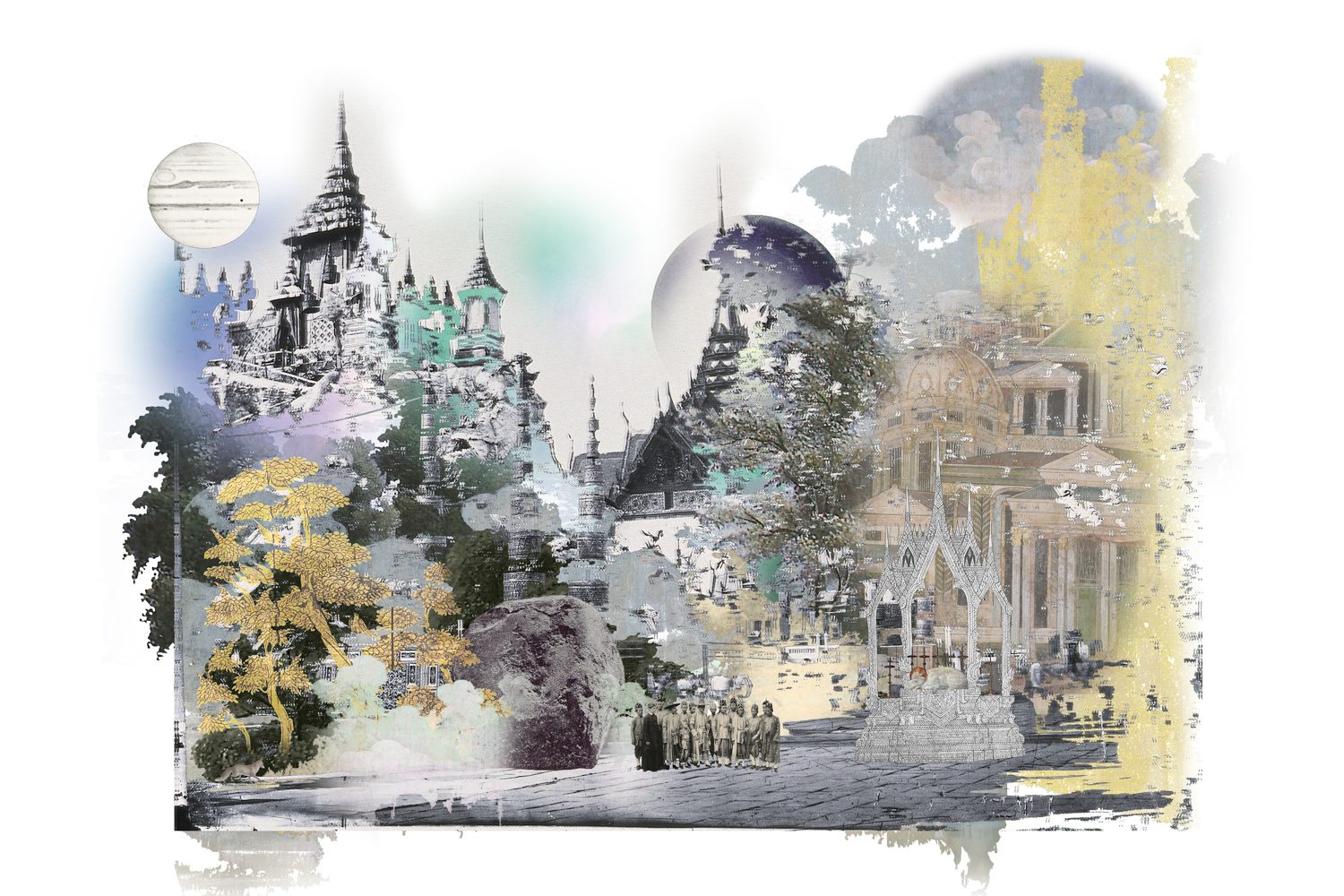ART4D SPEAKS WITH NAKROB MOONMANAS ABOUT HIS 1-YEAR ARTIST RESIDENCY IN PARIS AND THE EXPLORATION OF THE NEW TERRITORY OF ART AND HIMSELF
TEXT: PRATARN TEERATADA
PHOTO COURTESY OF NAKROB MOONMANAS
(For Thai, press here)
Nakrob Moonmanas, a Thai major graduate from the Faculty of Arts, Chulalongkorn University, is an artist whose artistic expression through distinctive use of collage and contemporary graphic conveys an intriguing amalgamation between Thai and western aesthetics of the past. Known for his idiosyncratic artistic identity, Nakrob assembles images from old magazines to create collages that illustrate subject matters, which revolve around history, social issues, cultures, literature, and mythology. Last year (2021), he travelled to Paris, France, on a scholarship, and accumulated new experiences, which led to the birth of the exhibition titled, PhotoAlchemy held in Bangkok, in late 2021. art4d invited Nakrob to talk about his experiences in Paris and artistic developments he has gone through from the very beginning to today.
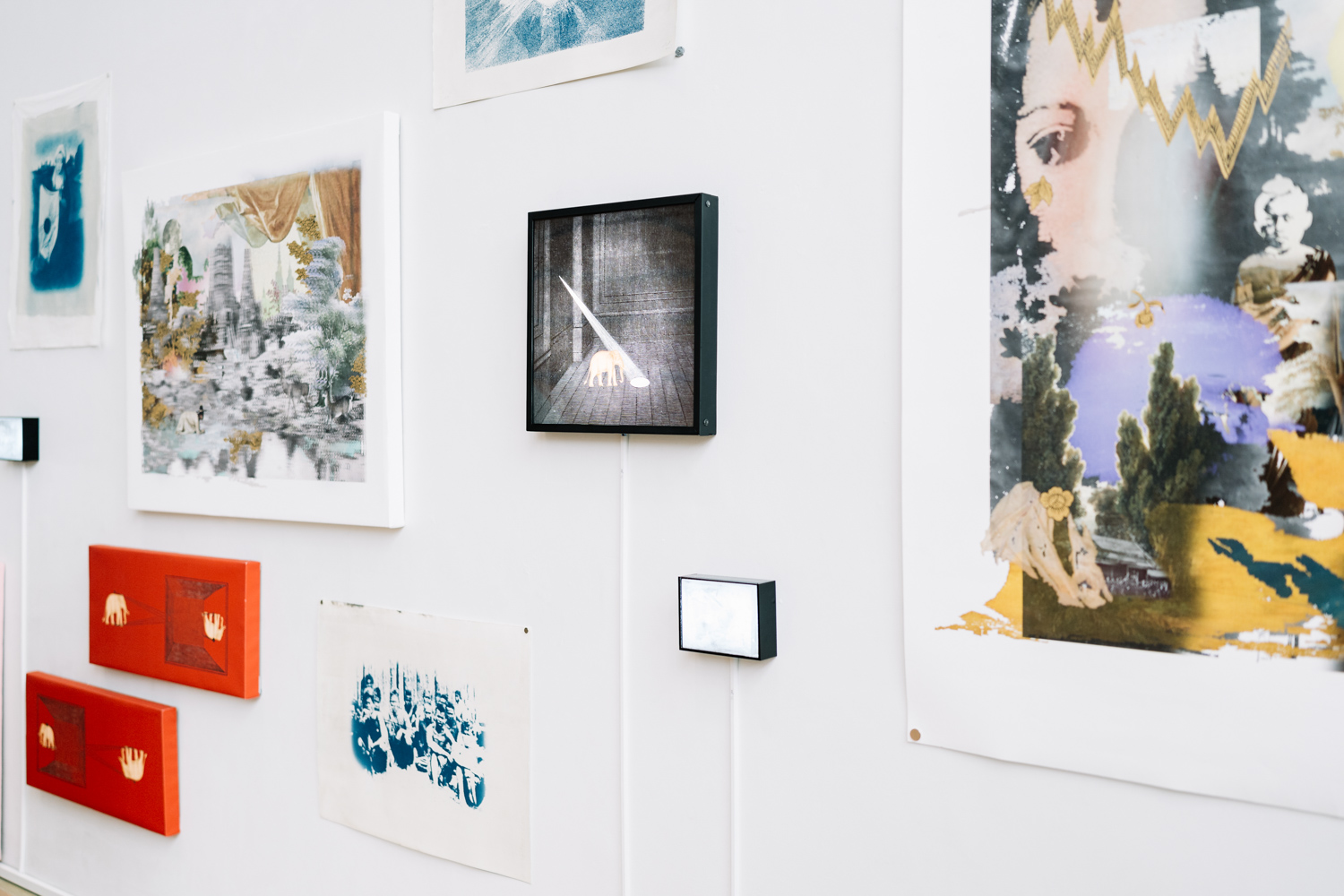
art4d: As an artist in residence in Paris, do you have any interesting experiences you would like to share with us?
Nakrob Moonmanas: I learned a lot of things from the time I spent there when the world was experiencing uncertainties caused by the pandemic. The first month I was there, Paris was under a major lockdown so the plans I made to go to all these different places and do all different things went down the drain. Having to spend most of my time in the studio, I looked back and explored through what I have done and I thought a lot about the future. Luckily, Cité internationale des arts where my residency took place, sympathized with the fact that there were artists who traveled all the way to Paris but weren’t able to do anything because everything was closed and everyone had to stay home, so they came up with this project for the people who wished to extend their stay to write up proposals, outlining and stating our intention to stay in Paris longer. So from the initial three-month duration, I was able to extend my residency to almost a year, and I got to be there when the city reopened.
Since Cité internationale des arts has over 300 studios under their supervision, and these studios are not limited to visual artists, it was a great opportunity for me to meet and exchange experiences with fellow artists from such diverse backgrounds and disciplines, from writers, curators, directors, photographers, dancers, architects, musicians, designers, academics, etc. Cité encourages each artist to organize an open studio so that other artists and outsiders could come to your studio and see your works. My works heavily reference Thai history, and they deal with quite specific subject matters and contexts. But having worked at the open studio, I was able to discover that even viewers who didn’t have that profound, in-depth background about Thai history, were still able to grasp these issues especially stories about culture clashes as well as the colonial and post-colonial periods. So, being able to listen to viewers’ opinions and insights that were so much different and broader from what I’ve heard, I was able to visualize and materialize the perspectives and trajectories that I would want to take with my storytelling including new possibilities for my art to evolve and develop.
When I was in Paris, Thailand saw the eruption of one of the country’s most crucial political movements and having to witness that from afar was such a bizarre experience. Being able to join overseas political gatherings, and having met some of the people who were forced to seek political asylum here, I realized a lot of things. While Thailand has been fighting for basic human rights or freedom of speech, people in Paris were protesting for their rights to refuse vaccination, or the rights to criticize religions. Many people look at Paris and they see it as this city of romance, art and fashion, but to me, Paris has its own, deeply rooted socio-political history, which has had a great deal of influences on France as well as the rest of the world, even a land that’s physically so far away such as Thailand. I always keep this fact at the back of my mind that Paris is where the ideation of the Siamese revolution of 1932 took place.

art4d: Could you tell us about your latest exhibition?
NM: My latest exhibition was held at Alliance Française Bangkok and it’s sort of a continuum of what I did during my artist residency. While I was there, my friends, an Italian photographer and German artist asked me to participate in a group exhibition called Alchemy. I got to do some research on the subject and the aspect I was particularly interested in and used with my work is Siam’s social and historical evolution during the modernization era and its complicated relationship with the colonialist countries since they’re the topics that I’m already familiar with. We saw how cultural inventions such as photography set its foot in Siam around two centuries ago and the way it was closely associated with this subject matter. Prior to the time when photography was introduced, the people of Siam viewed the replication of one’s individuality as something related to superstition. The arrival of the first camera, brought into Siam by a French missionary, challenged the belief while some Thai elites were beginning to be more open and accepting to these new western progresses. We could, therefore, view photography as a form of alchemy, which was neither entirely scientific while not fully natural nor supernatural. Photography also allowed Siamese people to explore and present their visual appearances to the outside world for the first time, even though it was through the eyes of western photographers using a camera, which was a tool that was considered highly modern at the time.
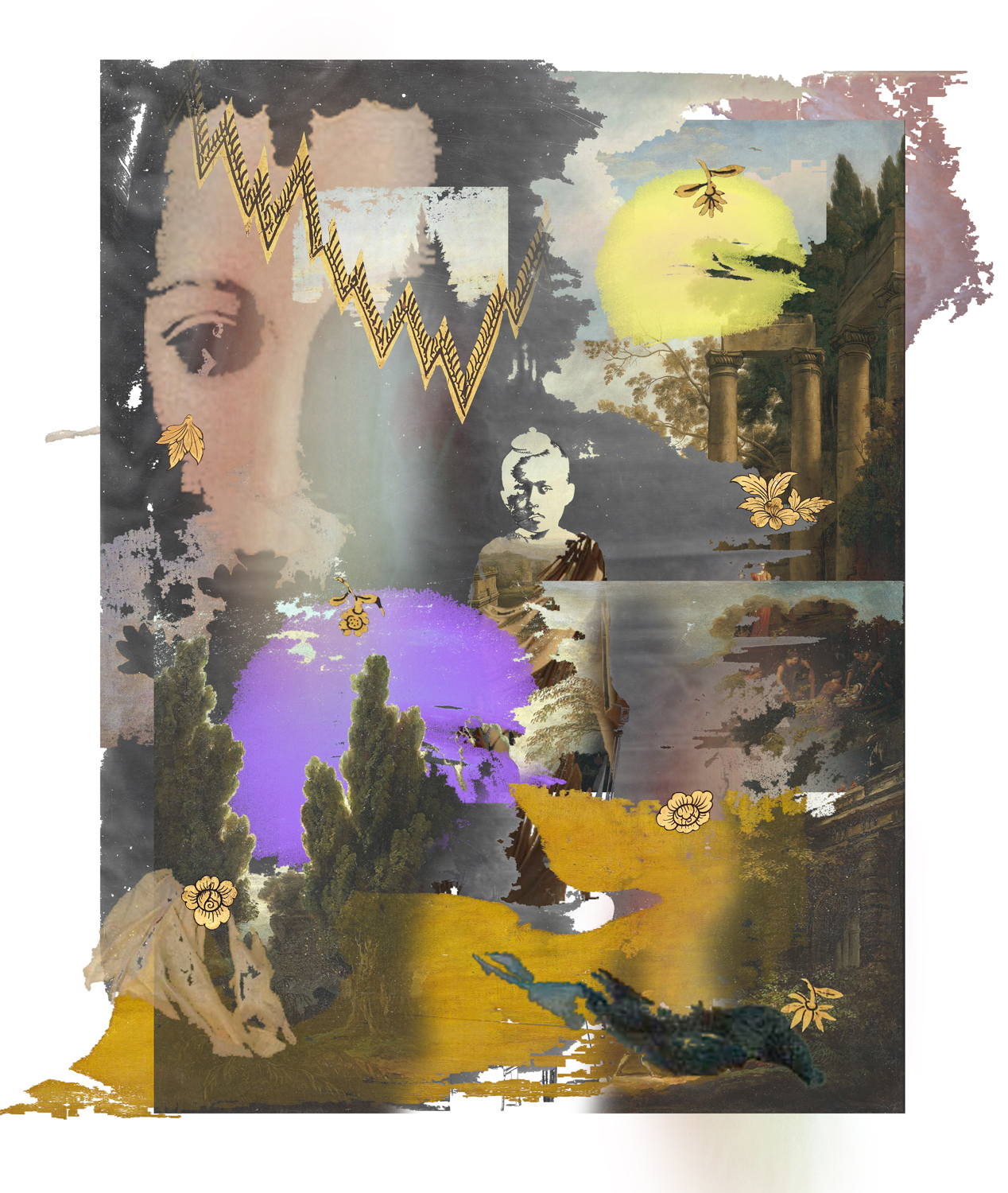 This is why the exhibition was called PhotoAlchemy. And from that small beginning as a part of an exhibition in Paris, to the continuum, which took place in Thailand, I had to further develop the ideas that I had and made several more connections such as the idea of photography as a cycle. My work starts off as a study of the past, which includes old photographs from old archives. I took these original photographs and collaged them on a computer graphic program, which I see as a progressive and advanced byproduct of photography, and there is this current, contemporaneous dimension to it. I printed them out and sent them over to a photographer who specializes in collodion wet plate process and created the final results. It’s a reversed process that allows me to revisit the past. But with this process, the past becomes this mixture of times, intertwined and almost inseparable.
This is why the exhibition was called PhotoAlchemy. And from that small beginning as a part of an exhibition in Paris, to the continuum, which took place in Thailand, I had to further develop the ideas that I had and made several more connections such as the idea of photography as a cycle. My work starts off as a study of the past, which includes old photographs from old archives. I took these original photographs and collaged them on a computer graphic program, which I see as a progressive and advanced byproduct of photography, and there is this current, contemporaneous dimension to it. I printed them out and sent them over to a photographer who specializes in collodion wet plate process and created the final results. It’s a reversed process that allows me to revisit the past. But with this process, the past becomes this mixture of times, intertwined and almost inseparable.
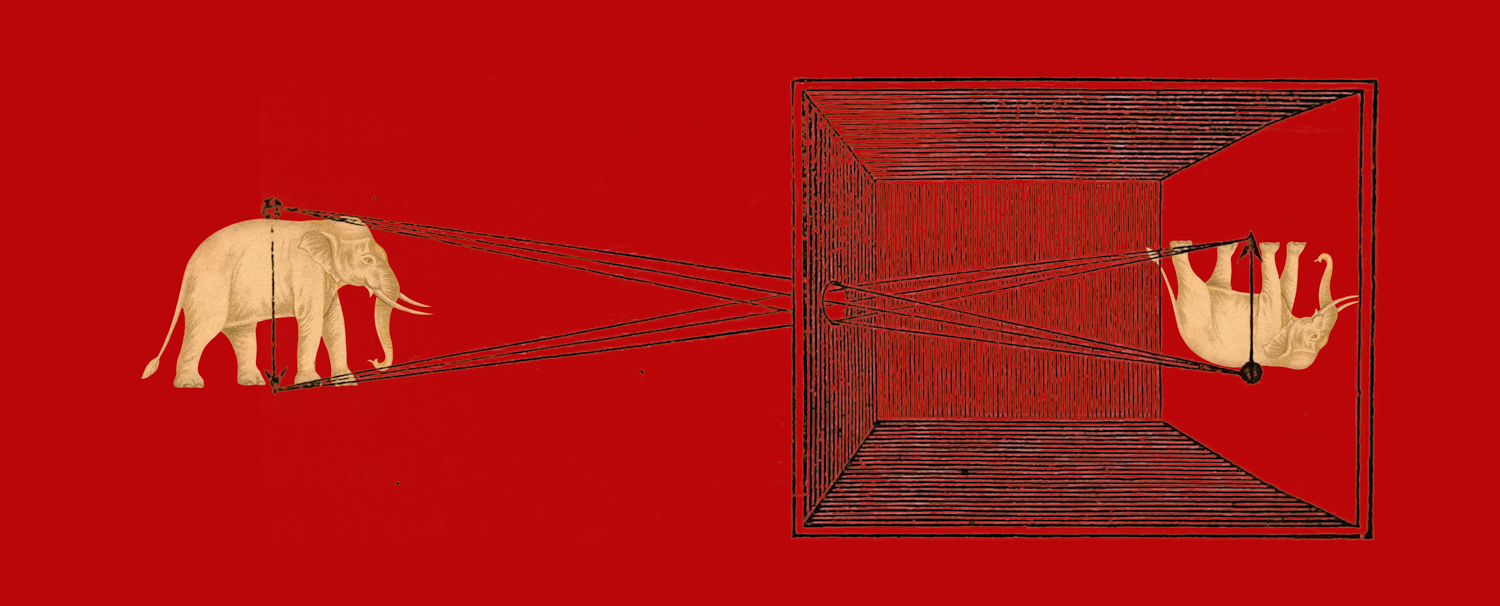
 During that work process, I had this idea that the original meaning of the word photo is light, so I thought of the solar eclipse phenomenon that took place in the latter half of King Rama 4’s reign. The incident marks a pivotal turn in the view that the Thai elites had for the universe and the world. In the meantime, the solar eclipse seems like a reversed process in photography, between that flash of light that allowed a moment to be captured, to a momentary absence of light that has been documented and remembered in so many ways, hundreds of years later. The story may seem like it’s about the past but it does reflect, even though vaguely, the current scenario where our society is still facing this dilemma where we cannot decide whether to continue to evolve along with the world or keep holding on to what we believe is our true, original identity.
During that work process, I had this idea that the original meaning of the word photo is light, so I thought of the solar eclipse phenomenon that took place in the latter half of King Rama 4’s reign. The incident marks a pivotal turn in the view that the Thai elites had for the universe and the world. In the meantime, the solar eclipse seems like a reversed process in photography, between that flash of light that allowed a moment to be captured, to a momentary absence of light that has been documented and remembered in so many ways, hundreds of years later. The story may seem like it’s about the past but it does reflect, even though vaguely, the current scenario where our society is still facing this dilemma where we cannot decide whether to continue to evolve along with the world or keep holding on to what we believe is our true, original identity.
With this exhibition, I utilize different techniques from something that’s directly involved with the photography process like cyanotype, collodion wet plate, to manually developing a film, all the way to traditional Thai painting techniques like gilding, all of which are used with the images generated by a computer graphic software with traces of incomplete pixels left visible, representing the superimposition of times and places.
art4d: What are the changes in your artistic evolution, from the first day to now, in terms of style, skills or stories you want to tell?
NM: With PhotoAlchemy. I was able to do something quite different. In terms of my thought process, since I wasn’t directly trained in fine art and have been more familiar with literary analysis and interpretation, the starting point of my artistic process tends to fall into methods and approaches mostly taken by illustrators. My work always reference some sort of text whether it’s from literature or history. Time passed and I learned more about Contemporary art and having spent time with many contemporary artist friends who are focusing on multidisciplinary works during my residency has really opened up my perspective about the world and has encouraged me to do something different, new and more experimental. It makes me want to break these walls that frame illustration and go beyond the world of commercial art to explore new territories. Stylistically, I try to get out of my comfort zone by searching for new possibilities in collage, such as using texts from literature as a material instead of images or trying to create collages that break away from the figurative frames. In the meantime, my interest in literature and history is still the core of my work. Literary theories are still the lens I use to tell stories and talk about different subject matters. My personal growth, which has taken place alongside Thai society’s significant changes and developments in these past recent years, and the many challenges the world is going through, and everything collectively contributes to the way my work matures and ramifies. The plain East meets West concept or a simple fuse of contrasting cultural representations and symbols like a mash-up between a Western painting and traditional Thai crown may not be able to fully answer the questions I’m asking. I’m exploring stories and images in the past that reflect the challenges of the present world, dusting things up, collaging things together and re-presenting them to the world.

